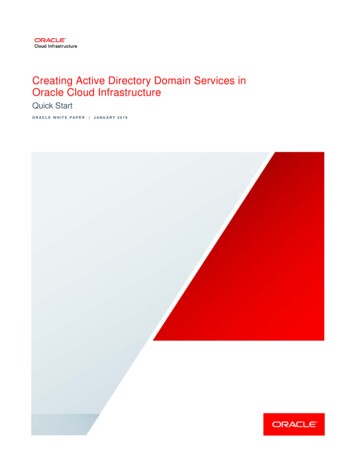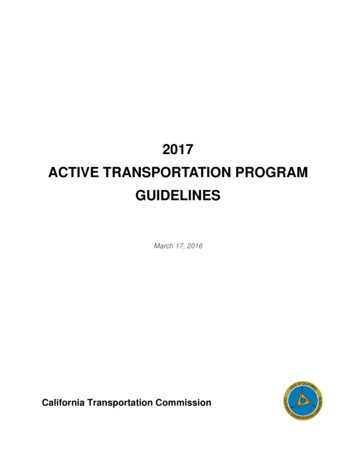
Transcription
2017ACTIVE TRANSPORTATION PROGRAMGUIDELINESMarch 17, 2016California Transportation Commission
CALIFORNIA TRANSPORTATION COMMISSION2017 ATP GUIDELINESTABLE OF CONTENTSI.1.2.3.Introduction . 1Background . 1Program Goals . 1Program Schedule . 14.5.6.7.8.Funding . 2Source . 2Distribution. 2Matching Requirements . 4Funding for Active Transportation Plans . 4Reimbursement . 4II.III. Eligibility . 59.Eligible Applicants . 510. Partnering With Implementing Agencies . 611. Eligible Projects . 612. Minimum Request For Funds . 813. Project Type Requirements . 8IV. Project Selection Process .1214. Project Application .1215. Sequential Project Selection .1216. MPO Competitive Project Selection.1217. Screening Criteria .1318. Scoring Criteria .1319. Project Selection between Project Applications with the Same Score .1520. Project Evaluation Committee .15V.Programming .15VI. Allocations .16VII.Project Delivery .1721. Federal Requirements .1822. Design Standards .1923. Project Inactivity .1924. Project Reporting .19VIII. Roles And Responsibilities .2025. California Transportation Commission (Commission) .2026. California Department of Transportation (Caltrans) .2127. Metropolitan Planning Organizations (MPOs) With Large Urbanized Areas .2128. Regional Transportation Planning Agencies (RTPAs) Outside an MPO with LargeUrbanized Areas and MPOs without Large Urbanized Areas .2229. Project Applicant .22IX. Program Evaluation .23i
California Transportation Commission2017 ATP GuidelinesMarch 2016I. Introduction1. BackgroundThe Active Transportation Program (ATP) was created by Senate Bill 99 (Chapter 359, Statutesof 2013) and Assembly Bill 101 (Chapter 354, Statutes of 2013) to encourage increased use ofactive modes of transportation, such as biking and walking.These guidelines describe the policy, standards, criteria, and procedures for the development,adoption and management of the ATP. The guidelines were developed in consultation with theWorkgroup. The workgroup includes representatives from Caltrans, other government agencies,and active transportation stakeholder organizations with expertise in pedestrian and bicycleissues, including Safe Routes to School programs.The Commission may amend the ATP guidelines after conducting at least one public hearing.The Commission must make a reasonable effort to amend the guidelines prior to a call for projectsor may extend the deadline for project submission in order to comply with the amended guidelines.2. Program GoalsPursuant to statute, the goals of the Active Transportation Program are to: Increase the proportion of trips accomplished by biking and walking. Increase the safety and mobility of non-motorized users. Advance the active transportation efforts of regional agencies to achieve greenhouse gasreduction goals as established pursuant to Senate Bill 375 (Chapter 728, Statutes of 2008)and Senate Bill 391 (Chapter 585, Statutes of 2009). Enhance public health, including reduction of childhood obesity through the use ofprograms including, but not limited to, projects eligible for Safe Routes to School Programfunding. Ensure that disadvantaged communities fully share in the benefits of the program. Provide a broad spectrum of projects to benefit many types of active transportation users.3. Program Schedule and Funding YearsThe guidelines for the third program of projects must be adopted by March 17, 2016.New programming capacity for the 2017 ATP will be for state fiscal years 2019/20 and 2020/21.Each programs must be adopted not later than April 1 of each odd-numbered year; however, theCommission may alternatively elect to adopt a program annually.1
California Transportation Commission2017 ATP GuidelinesMarch 2016The following schedule lists the major milestones for the development and adoption of the 2017ATP:Draft ATP Guidelines and Application presented to CommissionJanuary 20-21, 2016Commission hearing and adoption of ATP GuidelinesMarch 17, 2016*Call for projectsApril 15, 2016Commission adopts ATP Fund EstimateMay 18, 2016*Large MPOs submit optional guidelines to CommissionJune 1, 2016Project applications to Caltrans (postmark date)June 15, 2016Commission approves or rejects MPO guidelinesJune 29-30, 2016*Staff recommendation for statewide and small urban and ruralportions of the programCommission adopts statewide and small urban and rural portions ofthe programProjects not programmed distributed to large MPOs based onlocationDeadline for MPO project programming recommendations to theCommissionCommission adopts MPO selected projectsOctober 28, 2016December 7-8, 2016*December 7-8, 2016January 27, 2017March 2017*Dates coincide with the Commission’s adopted 2016 CTC meetingcalendar.II. Funding4. SourceThe Active Transportation Program is funded from various federal and state funds appropriatedin the annual Budget Act. These are: 100% of the federal Transportation Alternative Program funds, except for federalRecreation Trail Program funds appropriated to the Department of Parks and Recreation. 21 million of federal Highway Safety Improvement Program funds or other federal funds. State Highway Account funds.In addition to furthering the goals of this program, all Active Transportation Program projects mustmeet eligibility requirements specific to at least one Active Transportation Program fundingsource.5. DistributionState and federal law segregate the Active Transportation Program into multiple, overlappingcomponents. The Active Transportation Program Fund Estimate must indicate the funds available2
California Transportation Commission2017 ATP GuidelinesMarch 2016for each of the program components. Consistent with these requirements, the ActiveTransportation Program funds must be distributed as follows: Forty percent to Metropolitan Planning Organizations (MPO) in urban areas withpopulations greater than 200,000.These funds must be distributed based on total MPO population. The funds programmedand allocated under this paragraph must be selected through a competitive process bythe MPOs in accordance with these guidelines.Projects selected by MPOs may be in large urban, small urban, or rural areas.A minimum of 25% of the funds distributed to each MPO must benefit disadvantagedcommunities.The following statutory requirements apply specifically to the Southern CaliforniaAssociation of Governments (SCAG) oSCAG must consult with county transportation commissions, the Commission, andCaltrans in the development of competitive project selection criteria.oThe criteria used by SCAG should include consideration of geographic equity,consistent with program objectives.oSCAG must place priority on projects that are consistent with plans adopted by localand regional governments within the county where the project is located.oSCAG must obtain concurrence from the county transportation commissions.Ten percent to small urban and rural areas with populations of 200,000 or less, withprojects competitively awarded by the Commission to projects in those regions. Federallaw segregates the Transportation Alternative Program into separate small urban and ruralcompetitions based upon their relative share of the state population. Small Urban areasare those with populations of 5,001 to 200,000. Rural areas are those with populations of5,000 or less.A minimum of 25% of the funds in the Small Urban and Rural programs must benefitdisadvantaged communities.Projects within the boundaries of an MPO with an urban area with a population of greaterthan 200,000 are not eligible for funding in the Small Urban or Rural programs. Fifty percent to projects competitively awarded by the Commission on a statewide basis.A minimum of 25% of the funds in the statewide competitive program must benefitdisadvantaged communities.Additional minimums may be applied, such as a minimum for safe routes to schoolsprojects, subject to the annual State Budget Act.3
California Transportation Commission2017 ATP GuidelinesMarch 20166. Matching RequirementsAlthough the Commission encourages the leveraging of additional funds for a project, matchingfunds are not required. If an agency chooses to provide match funds, those funds cannot beexpended prior to the Commission allocation of Active Transportation Program funds in the sameproject phase (permits and environmental studies; plans, specifications, and estimates; right-ofway; and construction). Matching funds must be expended concurrently and proportionally to theActive Transportation Program funds. The Matching funds may be adjusted before or shortly aftercontract award to reflect any substantive change in the bid compared to the estimated cost of theproject.Large MPOs, in administering a competitive selection process, may require a funding match forprojects selected through their competitive process. Applicants from within a large MPO shouldbe aware that the match requirements may differ between the MPO and statewide competitiveprograms.7. Funding for Active Transportation PlansFunding from the Active Transportation Program may be used to fund the development ofcommunity-wide active transportation plans within or, for area-wide plans, encompassingdisadvantaged communities, including bike, pedestrian, safe routes to schools, or comprehensiveactive transportation plans. A list of the components that must be included in an activetransportation plan can be found in Section 13, subsection E.The Commission intends to set aside up to 2% of the funds in the statewide competitivecomponent and in the small urban and rural component for funding active transportation plans inpredominantly disadvantaged communities. A large MPO, in administering its portion of theprogram, may make up to 2% of its funding available for active transportation plans indisadvantaged communities within the MPO boundaries.The first priority for the funding of plans will be for cities, counties, county transportationcommissions, regional transportation planning agencies, MPOs, school districts, or transit districtsthat have neither a bicycle plan, a pedestrian plan, a safe routes to schools plan, nor acomprehensive active transportation plan. The second priority for the funding of plans will be forcities, counties, county transportation commissions, regional transportation planning agencies, orMPOs that have a bicycle plan or a pedestrian plan but not both. The lowest priority for fundingof plans will be for updates of active transportation plans older than 5 years.Applications for plans may not be combined with applications for infrastructure or oth
2017 ATP Guidelines March 2016 1 I. Introduction 1. Background The Active Transportation Program (ATP) was created by Senate Bill 99 (Chapter 359, Statutes of 2013) and Assembly Bill 101 (Chapter 354, Statutes of 2013) to encourage increased use of active modes of
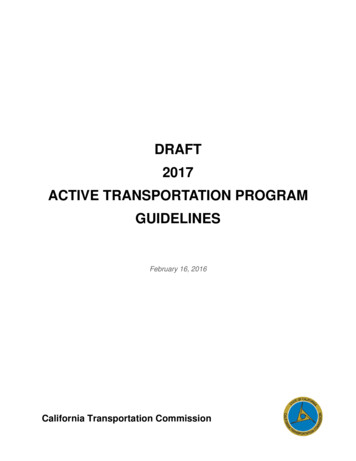

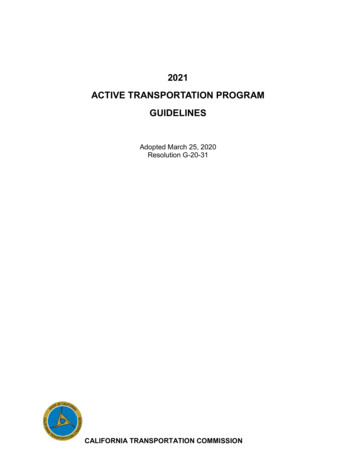

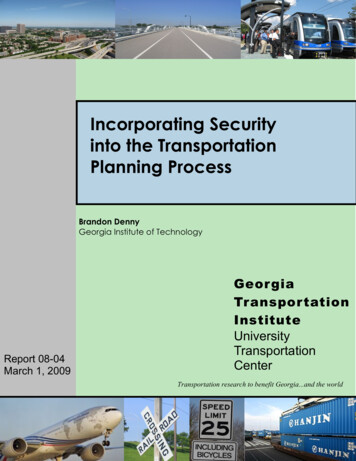
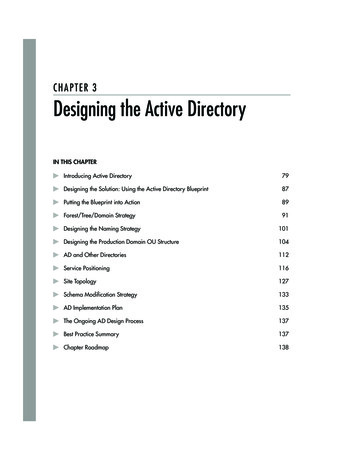



![[MS-ADFSOD]: Active Directory Federation Services (AD FS .](/img/1/5bms-adfsod-5d.jpg)
